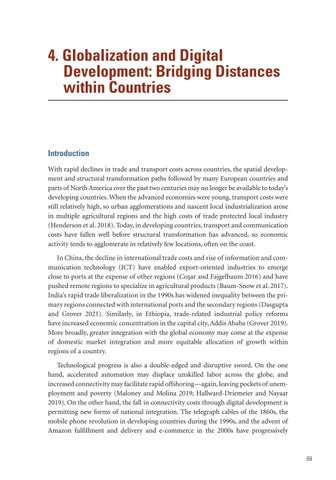4. Globalization and Digital Development: Bridging Distances within Countries
Introduction With rapid declines in trade and transport costs across countries, the spatial development and structural transformation paths followed by many European countries and parts of North America over the past two centuries may no longer be available to today’s developing countries. When the advanced economies were young, transport costs were still relatively high, so urban agglomerations and nascent local industrialization arose in multiple agricultural regions and the high costs of trade protected local industry (Henderson et al. 2018). Today, in developing countries, transport and communication costs have fallen well before structural transformation has advanced, so economic activity tends to agglomerate in relatively few locations, often on the coast. In China, the decline in international trade costs and rise of information and communication technology (ICT) have enabled export-oriented industries to emerge close to ports at the expense of other regions (Coşar and Fajgelbaum 2016) and have pushed remote regions to specialize in agricultural products (Baum-Snow et al. 2017). India’s rapid trade liberalization in the 1990s has widened inequality between the primary regions connected with international ports and the secondary regions (Dasgupta and Grover 2021). Similarly, in Ethiopia, trade-related industrial policy reforms have increased economic concentration in the capital city, Addis Ababa (Grover 2019). More broadly, greater integration with the global economy may come at the expense of domestic market integration and more equitable allocation of growth within regions of a country. Technological progress is also a double-edged and disruptive sword. On the one hand, accelerated automation may displace unskilled labor across the globe, and increased connectivity may facilitate rapid offshoring—again, leaving pockets of unemployment and poverty (Maloney and Molina 2019; Hallward-Driemeier and Nayaar 2019). On the other hand, the fall in connectivity costs through digital development is permitting new forms of national integration. The telegraph cables of the 1860s, the mobile phone revolution in developing countries during the 1990s, and the advent of Amazon fulfillment and delivery and e-commerce in the 2000s have progressively
69

